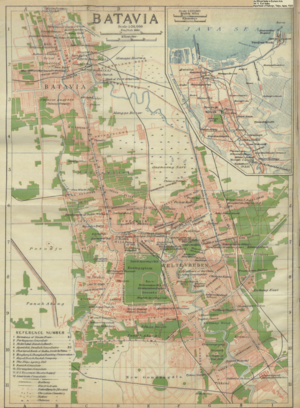From Wikipedia, the free encyclopedia
Trams in Jakarta Locale Jakarta , Indonesia Status Closed
Horsecar era: 1869 (1869 ) –1883 (1883 )
Status
Closed
Operator(s)
Bataviasche Tramweg-Maatschappij
Track gauge
1188 mm
Propulsion system(s)
Horses
Steam tram era: 1883 (1883 ) –1933 (1933 )
Status
Closed
Operator(s)
Dummler & Co.
Track gauge
1188 mm
Propulsion system(s)
Steam
Overview
The Jakarta tram system was a transport system in Jakarta , Indonesia . Its first-generation tram network first operated as a horse tram system , and was eventually converted to electric trams in the early twentieth century.
Rolling stock
The list provide only steam-tram rolling stock of Batavia until the year 1924.[ 1]
Type
Manufacturer
Year
Quantity
NITM number
Seats capacity
Standing capacity
Picture
Remarks
Trailer
Bonnefond
1869
unknown
unknown
40
unknown
Horse-drawn (3-4 horses), 1188mm gauge
Fireless locomotive
Hohenzollern
1882-1883
21
1-21
not applicable
not applicable
1188mm gauge
Fireless locomotive
Hohenzollern
1884-1907
13
22-34
not applicable
not applicable
1188mm gauge
Steam locomotive
Hohenzollern
1921
17
51-67
not applicable
not applicable
1067mm gauge
Trailer type A
Beynes
1882
14
1-14
16
16
Became BVM A1-A14
Trailer type B
Beynes
1882
14
51-64
26
16
52 & 55 became type A 80 & 81 in 1925. 23 survivors became BVM B101-B123
Trailer type A
Beynes
1882-1889
9
91-99
24
16
Trailer type B
Beynes
1882-1889
7
101-107
34
16
Became BVM AB201-AB207
Trailer type B
Beynes
1883
2
151, 152
40
16
Became BVM AB208, AB209
Trailer type AB
Beynes
1884
2
202, 202
40
16
Trailer type c\C
Beynes
1887-1897
14
251-264
40
28
Became BVM AB208, AB209
Trailer type AB
Beynes
1897
2
211, 212
40
16
Trailer type AB
NITM
1904
6
221-226
40
20
Became BVM AB253, AB254, AB256, C505, C506, C508
Pikolanwagen
Werkspoor
1904-1924
28
1-28
not applicable
not applicable
23 survivors became P1-P23
Trailer type C
NITM
1908-1810
7
271-277
40
28
274, 275 & 277 became type AB 231-233 in 1928. Later became 501, 507 & 508.
Trailer type AB
Werkspoor
1922-1923
21
301-321
36
28
Became BVM AB301-AB318, C422-C424
Trailer type C
Werkspoor
1922-1923
21
401-421
42
53
Became BVM C401-C421
Gallery
A horse tram passing Batavia's
Amsterdam Gate in 1880.
The steam tram in front of the Postspaarbank showing trams for three divided social classes.
An electric tram in the Kramat – Tanah Abang tram route.
The overflowing tram in Jakarta year 1946.
The remains of the former Jakarta tram tracks in
Glodok .
See also
References
Cited works
Dick, Howard; Rimmer, Peter J. (2003). Cities, Transport and Communications - The Integration of Southeast Asia since 1850 . Palgrave Macmillan. ISBN 9781349390229 Duparc, H.J.A. (1972). Trams en Tramlijnen: De Elektrische Stadstrams op Java . Rotterdam: Wyt. ISBN 9789060075821 Merrillees, Scott (2015). Jakarta: Portraits of a Capital 1950-1980 ISBN 9786028397308 Sulaeman, Adriansyah Yasin (2017). Trem Batavia, Mutiara Transportasi Jakarta Yang Terlupakan Batavian Tram, The Forgotten Pearl of Jakarta's Transportation ]. Breda: Issuu. Teeuwen, Dirk (2010). "From horsepower to electrification - Tramways in Batavia-Jakarta 1869-1962" (PDF) . Rendez-vous Batavia . Indonesia-Dutch Colonial Heritage. Retrieved April 22, 2017 .







